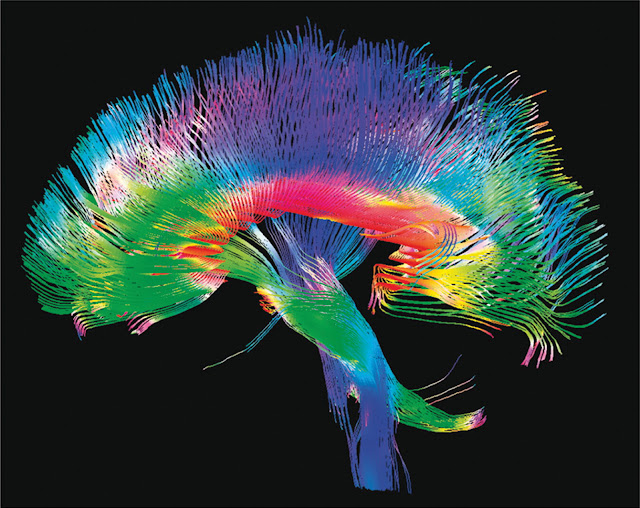A Brain of One's Own
Every human brain is unique, with its own strengths and weaknesses. IQ, executive function, and other critical components of cognition and behaviour are genetically determined, in large part, but understanding the way in which genes determine behaviour and cognition is a complex challenge.
Genes help determine the nature of the brain's connectome, above, and the speed at which nerve transmissions can move along the connectome, between brain centres. Genes also influence brain plasticity via new stem cell production controlling the ability to form new memories.
Genes influence the ability to transfer attention to the more salient aspects of one's environment. This ability has always been a crucial survival trait.
Genes influence both the soundness of a person's feelings and intuition, and the trust that a person has in his own feelings. The sounder the intuition, the better able one is to predict future events and trends. Such prediction has always been a crucial survival trait.
Centre for Motivation? SD
An individual's strength and soundness of motivation helps to determine his ultimate destiny in life -- regardless of the underlying cultural substrate. Scientists are beginning to better understand the brain mechanisms of motivation.
Understanding the brain requires a certain level of comprehension of mechanisms operating at multiple levels simultaneously, from the molecular to the behavioural. It also requires an apprehension of circular causality, without which the brain could not function.
Each of us has a unique brain. The uniqueness of our brains is guaranteed by uniquely complex genetic sequences and mechanisms, but also by the unique environments within which these genetic mechanisms have played out.
We have barely begun to learn how our brains create us and our world. It is a great challenge, made all the greater by the incalculable variety that we comprise.
Genes help determine the nature of the brain's connectome, above, and the speed at which nerve transmissions can move along the connectome, between brain centres. Genes also influence brain plasticity via new stem cell production controlling the ability to form new memories.
Genes influence the ability to transfer attention to the more salient aspects of one's environment. This ability has always been a crucial survival trait.
Genes influence both the soundness of a person's feelings and intuition, and the trust that a person has in his own feelings. The sounder the intuition, the better able one is to predict future events and trends. Such prediction has always been a crucial survival trait.
An individual's strength and soundness of motivation helps to determine his ultimate destiny in life -- regardless of the underlying cultural substrate. Scientists are beginning to better understand the brain mechanisms of motivation.
Using images obtained from the MRI scans taken during the test, Mathias Pessiglione and his team identified a general motivational system in the depths of the brain, i.e. a structure capable of activating any effort type, both mental (concentrating on the task in hand) or physical (lifting a load). The researchers observed that the ventral striatum was activated in proportion to the amount of money involved: the higher the degree of motivation, the higher the activation level. Furthermore, the ventral striatum is connected to the median part of the striatum (the caudate nucleus) when the task to be performed is cognitively difficult (when the physical size and the numerical value of the numbers did not correspond). This ventral region solicits the lateral part of the striatum (the putamen) when the difficulty is motor-related (when the handle had to be squeezed very tightly).More at PLoS Biology
The researchers suggest that the expectation of a reward is encoded in the ventral striatum, which can then drive either the motor or cognitive part of the striatum, depending on the task, in order to boost performance. _SD
Understanding the brain requires a certain level of comprehension of mechanisms operating at multiple levels simultaneously, from the molecular to the behavioural. It also requires an apprehension of circular causality, without which the brain could not function.
Each of us has a unique brain. The uniqueness of our brains is guaranteed by uniquely complex genetic sequences and mechanisms, but also by the unique environments within which these genetic mechanisms have played out.
We have barely begun to learn how our brains create us and our world. It is a great challenge, made all the greater by the incalculable variety that we comprise.
Labels: brain research, executive function, Intelligence, intuition



0 Comments:
Post a Comment
“During times of universal deceit, telling the truth becomes a revolutionary act” _George Orwell
<< Home